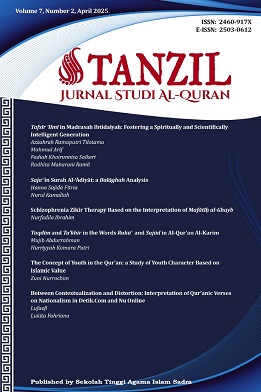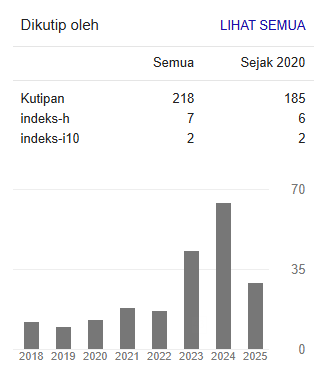THE CONCEPT OF YOUTH IN THE QUR’AN
A STUDY OF YOUTH CHARACTER BASED ON ISLAMIC VALUES
DOI:
https://doi.org/10.20871/tjsq.v7i2.411Keywords:
Qur’an, Thematic Exegesis, Values of Youth, Youth GenerationAbstract
This study aims to explore the concept of youth in the Qur’an through a thematic interpretation of five key terms that reflect the characteristics and values associated with young individuals: Aṣḥāb al-Kahfi, ghulāmin ḥalīm, bunayya, fatan/fityah, and dhurriyah. These terms were selected to represent ideal youth traits rooted in Qur’anic teachings. Using a qualitative research method with a thematic tafsir approach, this study systematically analyzes verses of the Qur’an to uncover these terms' deeper meanings and educational implications. The findings reveal that aṣḥāb al-kahfi symbolizes youth who are resilient and curious in their pursuit of truth; ghulāmin ḥalīm highlights gentleness, patience, and compassion; bunayya reflects filial piety and strong moral foundations; fatan/fityah illustrates courage and revolutionary spirit in upholding truth; and dhurriyah emphasizes the significance of nurturing generations that are faithful, morally upright, and spiritually steadfast. The study concludes that the Qur’anic concept of youth encompasses a holistic balance between intellectual competence, moral strength, courageous action, and spiritual resilience. These values are highly relevant for contemporary youth development and character education. The role of parents, educational institutions, and society at large is crucial in internalizing these values to shape youth into individuals of integrity, competitiveness, and positive societal impact.
References
Ali, Atabik, and Ahmad Zuhdi Muhdlor. Kamus Kontemprer Arab-Indonesia. Yogyakarta: Yayasan Ali Maksum Pondok Pesantren Krapyak, 1996.
Amin, Khairul. “Tipologi Pemuda dalam Al Qur’an (Analisis Historis-Psikologis).” Skripsi, UIN Sunan Kalijaga Yogyakarta, 2017. https://digilib.uin-suka.ac.id/id/eprint/29675/.
Anshori, Muhammad. “Pemuda dalam Al-Qur’an dan Hadis.” Jurnal Kajian Islam Interdisipliner 1, no. 2 (2016). https://doi.org/10.14421/jkii.v1i2.1060.
Bāqī, Muḥammad Fu’ad ‘Abd al-. Al-Mu‘jam al-Mufahras li-alfāẓ al-Qur’ān al-Karīm. Kairo: Dār al-Hadīth, n.d.
Bisri, Adib, and Munawwir A. Fatah. Kamus Al Bisri. Surabaya: Pustaka Progresif, 1999.
Fayrūzābādī, Majd al-Dīn Abū Ṭāhir Muḥammad ibn Yaʿqūb al-. Tanwīr al-Miqbās min Tafsīr Ibn ‘Abbās. Singapura: Al-Ḥaramayn, n.d.
Haider, Ghulam. “A Comparative Study of The Selected Qur’anic Exegesis Having Deep Impact on Youth.” Al Khadim Research Journal of Islamic Culture and Civilization 5, no. 1 (March 31, 2024): 90–99.
Hatta, Ahmad.The Great Qur’an. Jakarta: Maghfrah Pustaka, 2012.
Hasbullah, Mushollin, and Badarussyamsi Badarussyamsi. “Generasi Muda dalam Al-Qur’an Perspektif Tafsir Al-Azhar dan Tafsir Al-Misbah.” Journal of Comprehensive Islamic Studies 1, no. 2 (2022): 427–50.
Kathīr, ‘Imāduddin Abī al-Fidā’ Ismā‘īl Ibnu. Tafsīr al-Qur’ān al-‘Aẓīm. Vol. 3. Semarang: Toha Putra, n.d.
———. Tafsīr al-Qur’ān al-‘Aẓīm. Vol. 4. Semarang: Toha Putra, n.d.
Khalil, Syauqi Abu. Atlas Al-Qur’an. Translated by M. Abdul Ghaffar. Jakarta: Almahira, 2006.
Kholid, Amru. Potret Muhammad Saw. Sebelum dan Sesudah menjadi Nabi. Translated by Abdullah. Jakarta: Samara Publising, 2008.
Lembaga al-Kitab Indonesia Jakarta, Al-Kitab. Jakarta: Lembaga al-Kitab Indonesia, 2013.
Marpuah, Siti. “Moral Development Strategy in Shaping Youth Character through Al-Qur’an.” International Journal Corner of Educational Research 1, no. 1 (August 4, 2022): 55–61. https://doi.org/10.54012/ijcer.v1i1.78.
Nawawī, Muḥammad bin ‘Umar. Marāḥ Labīd li-Kashf Ma‘na al- Qur’ān al-Majīd. Vol. 2. Beirūt: Dār al-Kutub al-‘Ilmiyyah, 2017.
Noviani, Dwi, Nur Khasanah, Achmad Irwan Hamzani, and Havis Aravik. “The Value of Character Education: Study of Strengthening Al-Quran Literacy Culture for the Young Generation in the Disruptive Era 5.0.” Symfonia: Jurnal Pendidikan Agama Islam 4, no. 1 (June 30, 2024): 65–78. https://doi.org/10.53649/symfonia.v4i1.93.
O’Shaughnessy, Thomas J. “The Qurʾānic View of Youth and Old Age.” Zeitschrift Der Deutschen Morgenländischen Gesellschaft 141, no. 1 (1991): 33–51.
Qaida, Muhammad Al, and Ainur Rhain. “Characteristics of a Muslim Youth in the Qur’an Surah Yusuf, Verse 33, to Address Moral Decadence and the Free Lifestyle of Gen Z.” Proceeding ISETH (International Summit on Science, Technology, and Humanity), 2023, 2417–26. https://doi.org/10.23917/iseth.5158.
Sa‘dī, ‘Abdurraḥmān bin Nāṣir al-. Taysīr al-Karīm al-Raḥmān fī Tafsīr Kalām al-Mannān. Riyāḍ: Maktabah Ma‘ārif, 1999.
Sajjādī, Sayyid Ibrāhīm. “The Youth in the Qur’an.” Qur’anic Reserches 12, no. 46–47 (October 23, 2006): 278–307.
Shihab, M. Quraish. Tafsir al-Misbah: Pesan, Kesan dan Keserasian Al-Qur’an. Vol. 5. Jakarta: Lentera Hati, 2002.
———. Tafsir al-Misbah: Pesan, Kesan dan Keserasian Al-Qur’an. Vol. 7. Jakarta: Lentera Hati, 2002.
———. Tafsir al-Misbah: Pesan, Kesan dan Keserasian Al-Qur’an. Vol. 8. Jakarta: Lentera Hati, 2002.
———. Tafsir Al Misbah: Pesan, Kesan dan Keserasian Al-Qur’an. Vol. 11. Jakarta: Lentera Hati, 2002.
Syaikh, Abdullah bin Muhammad Alu. Lubabu al-Tafsir min Ibni Kathir. Translated by Abdul Ghaffar. Vol. 4. Jakarta: Pustaka Imam Syafi’i, 2008.
———. Lubabu al-Tafsir min Ibni Kathir. Translated by Abdul Ghaffar. Vol. 5. Jakarta: Pustaka Imam Syafi’i, 2008.
———. Lubabu al-Tafsir min Ibni Kathir. Translated by Abdul Ghaffar. Vol. 6. Jakarta: Pustaka Imam Syafi’i, 2008.
———. Lubabu al-Tafsir min Ibni Kathir. Translated by Abdul Ghaffar. Vol. 8. Jakarta: Pustaka Imam Syafi’i, 2008).
Wani, Misbahul. “Pemuda dalam Al-Qur’an dan As-Sunnah: Pemuda Islam yang Berkualitas Tidak Lepas dari Pendidikan Orang Tua yang Totalitas.” Al-Dzikra: Jurnal Studi Ilmu al-Qur’an dan al-Hadits 13, no. 1 (June 26, 2019): 71–94. https://doi.org/10.24042/al-dzikra.v13i1.2077.
Wati, Agusti Sukma. “Makna Fatā dalam Al-Qur’an (Pendekatan Kontekstual Abdullah Saeed).” Skripsi, IAIN Palangka Raya, 2022. http://digilib.iain-palangkaraya.ac.id/5197/.
Downloads
Published
How to Cite
Issue
Section
License
Copyright (c) 2025 Zuni Rurochim

This work is licensed under a Creative Commons Attribution 4.0 International License.






















